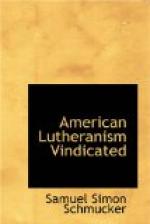1. Because we find two different articles of the Confession, the one with mass (Messe) for its caption, and the other headed: OF THE HOLY SUPPER (vom Heiligen Abendmahl.) Now, if mass here signified Holy Supper, the probability is that one or the other term would have been used in both places. The design of captions prefixed to a chapter or article, is to indicate the general contents of such article; and a diversity of caption or title, naturally raises the presumption that different subjects are discussed. The most natural method of deciding this question concerning the meaning of the caption, is to inquire what, are the subjects discussed in each article. If the subjects discussed in both articles are the same, then the captions are or ought to be synonymous, and as the Lord’s Supper never signifies mass in its specific sense, it follows that mass would have to mean Lord’s Supper. But if different subjects are treated of in the two articles, then the captions, if appropriate, must mean different things. Now, it will not be denied, that whilst the Article X., headed Lord’s Supper, discusses matter specifically relating to the eucharist, (namely the real presence of the body and blood of the Saviour in the Holy Supper;) the Article XXIV., headed the Mass, actually discusses what is specifically termed the mass, namely, the ceremony and acts of the priest or minister preceding the Lord’s Supper. Thus, the article states, “No perceptible change was made in the public ceremonies of the mass, except the addition of German hymns along with the Latin; but it is well known that there are no other “public ceremonies” connected with the Lord’s Supper in the Romish church, except those embraced in the mass, specifically so called, and that the Latin hymns were part of this mass, “Masses are bought and sold at annual fairs, and the greater part of them (the masses) in all the churches, were sold for money;” but we have never heard that Romanists had to pay for receiving the communion, it is only for a certain performance of the priest, called mass, that they pay the priest. These “money masses and closet masses,” are condemned; whilst no objection is made to public mass, at which the sacrament is administered; on the contrary, it is stated, that by proper instruction, “the people are attracted to communion and the mass.” The question is referred to “whether a mass performed for a number of persons collectively, was as efficacious as a separate mass for each individual;” but who ever heard of christians receiving one Lord’s Supper collectively, for a number of other persons, or for an individual? And if the thing is done by the priest, then it is what is specifically called mass. So also, who ever heard of the Lord’s Supper being received “for the dead;” but it is very common for the priest to say mass for the dead. Thus, might we add additional sentences from this Article XXIV., which applied to the Lord’s




